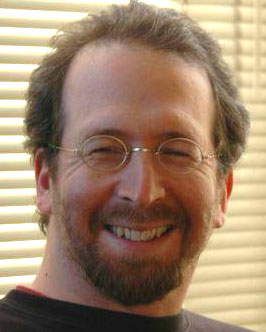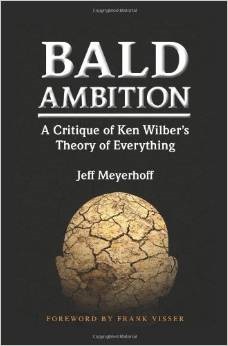|
TRANSLATE THIS ARTICLE
Integral World: Exploring Theories of Everything
An independent forum for a critical discussion of the integral philosophy of Ken Wilber
  Jeff Meyerhoff, M.A., L.S.W. is the author of "Bald Ambition: A Critique of Ken Wilber's Theory of Everything" and other essays on integral theory. He majored in economics and sociology and has studied philosophy, psychology, politics and spirituality. He's been employed as a social worker for the last 25 years. His weekly radio show, "The Ruminator," is archived at www.wmfo.org. His blog is www.philosophyautobiography.blogspot.com and his email is [email protected]. Jeff Meyerhoff, M.A., L.S.W. is the author of "Bald Ambition: A Critique of Ken Wilber's Theory of Everything" and other essays on integral theory. He majored in economics and sociology and has studied philosophy, psychology, politics and spirituality. He's been employed as a social worker for the last 25 years. His weekly radio show, "The Ruminator," is archived at www.wmfo.org. His blog is www.philosophyautobiography.blogspot.com and his email is [email protected].TABLE OF CONTENTSConclusionBald Ambition: Chapter 11Jeff Meyerhoff
Wilber's synthesis is creative and his life philosophy attractive, but there are too many anomalies for it to be considered a valid theory.
The theory of the Big Bang tells us that we can trace everything that exists back to a common birth moment. From the singularity of creation we get the multiplicity of existence. How did we get from an infinitely dense speck of matter to all that appears today? What is the unifying story of this interconnected Kosmos? Why is it all here and where is it all going? It is Ken Wilber's bald ambition to try to answer these questions by explaining how everything came to be, fits together and what it all means. Not just the theoretical physicist's theory of everything or the cosmologist's explanation of the cosmos, but a true Theory of Everything: matter, life, mind and spirit. The fact that this absurdly ambitious attempt cannot immediately be dismissed is a credit to Wilber's knowledge and imagination. But the fact that it does not succeed is not surprising given the enormous diversity of knowledge it must integrate and the unsustainability of much more modest systematic integrations. This book's initial question regarding Wilber - Einstein of consciousness or New Age pseudo-scientist? - was used for dramatic effect. There is a vast territory between these two. Wilber is a creative synthesizer whose interests span all types of knowledge in contrast to the narrow specialization prevalent in academia. He has done more than perhaps any other to forge a synthesis of Western and Eastern theories and practices of self-development. His grand theorizing does have real world applications and he is actively trying to institutionalize his work and propagate it to create individual and social change. He is an accomplished mystical practitioner and speaks knowledgeably about both the theoretical and experiential aspects of mysticism. His work shows signs of development as it loosens its grip on problematic notions like linear development and tries to incorporate perspectivism.[1] However, the deep dualities which Wilber's integration seeks to remedy are not resolved. Subject and object, science and spirit, individual and social are mapped and juxtaposed, but not integrated. There is the appearance of integration, but a closer look and an examination of the details yields contrary facts and inconsistencies. If a theory contradicts the facts or is inconsistent its validity is compromised. These are essential aspects of reason's method which must be satisfied if, as Wilber claims, he has transcended and integrated the rational stage within his larger synthesis. A common response to this type of criticism is that Wilber is working at a higher level of integration and that the “details” will be worked out in the future. Yet there is good reason it is said, in differing contexts, that God or the Devil resides in the details. God is said to be in the details when one experiences the sublime in concrete particulars; and the Devil is in the details when one encounters the anomaly whose stubborn factuality threatens one's seamless theoretical unity. And details don't only refer to those stubborn little bits. There is also the detailed examination of a large-scale theory which reveals whether there is or is not consistency. Previous chapters examined the academic literature Wilber does and does not cite and shows fundamental debates by the leading experts where Wilber contends there is consensus around orienting generalizations. The chapters on holarchy demonstrate the fundamental problems with the concepts and definitions Wilber uses to create his ontology and tenets of the Kosmos. Chapters on consciousness, social evolution, mysticism, postmodernism, western history, vision-logic, philosophy and methodology, and investigations in topics such as epistemology, the perennial philosophy, human violence, the Enlightenment and Romanticism show Wilber's mischaracterization of debates and the falseness of his contention of an academic consensus around his views. Wilber's strength as an imaginative synthesizer flying high over the “details” is also his downfall. Those so-called “details” are the debated and debatable knowledge from the various academic specialties. They are not, what Wilber calls, “already-agreed-upon,” “simple but sturdy” knowledge. The present state of knowledge does not provide the validation he needs to ground his speculative theorizing. Wilber's synthesis is creative and his life philosophy attractive, but there are too many anomalies for it to be considered a valid theory. Wilber and I offer different solutions to the problem of opposed perspectives. Wilber tries to solve it on the level of intellect; I try to solve it on the level of relationship - relationship to our own beliefs and to our opponent's. Wilber contends that he takes the truth in the other's perspective and incorporates it into his perspective, but what is deemed true in the other's perspective is dependent upon the character of the perspective doing the choosing. Wilber obscures this fact by claiming he's using the consensus knowledge or orienting generalizations of the sciences, yet I demonstrate that they don't exist or don't exist in the way he needs them to exist. The truth we take from others - the places where we agree - are dependent upon the character of our perspectives. While we will certainly value things differently and have our particular hierarchies of value, the way to mediate the differences in perspective is not through the creation of an illusory mega-perspective, but through the way we relate to the person holding the opposing perspective in the moments in which we are engaging that person. This approach would be problematic for Wilber as is apparent from his numerous acrimonious discussions with, or avoidance of, people who oppose his views too fundamentally. A fundamental assumption of Wilber's particular perspective is that there is one truth or way in which the world is. Consequently, if we take all the confirmed truths in all the different fields of knowledge and integrate them they should fit together because they are all pieces of one big puzzle. But there are many criteria of truth and so many different kinds of truth; some fit together, some overlap and some contradict. People today have to deal with this diversity of truths. The approach I advocate recognizes the postmodern insight of these many truths and surrenders the desire to be in possession of the one truth. We are then still left with differing perspectives, the people who hold them and the problem of how to get along. It is our relationship to the truths we hold dear and the nature of that dearness that I suggest we examine. REFERENCES[1] See his notes, “Excerpt D: The Look of a Feeling,” for the forthcoming volume in the Kosmos trilogy at http://wilber.shambhala.com/html/books/kosmos/excerptD/part1.cfm/
|
